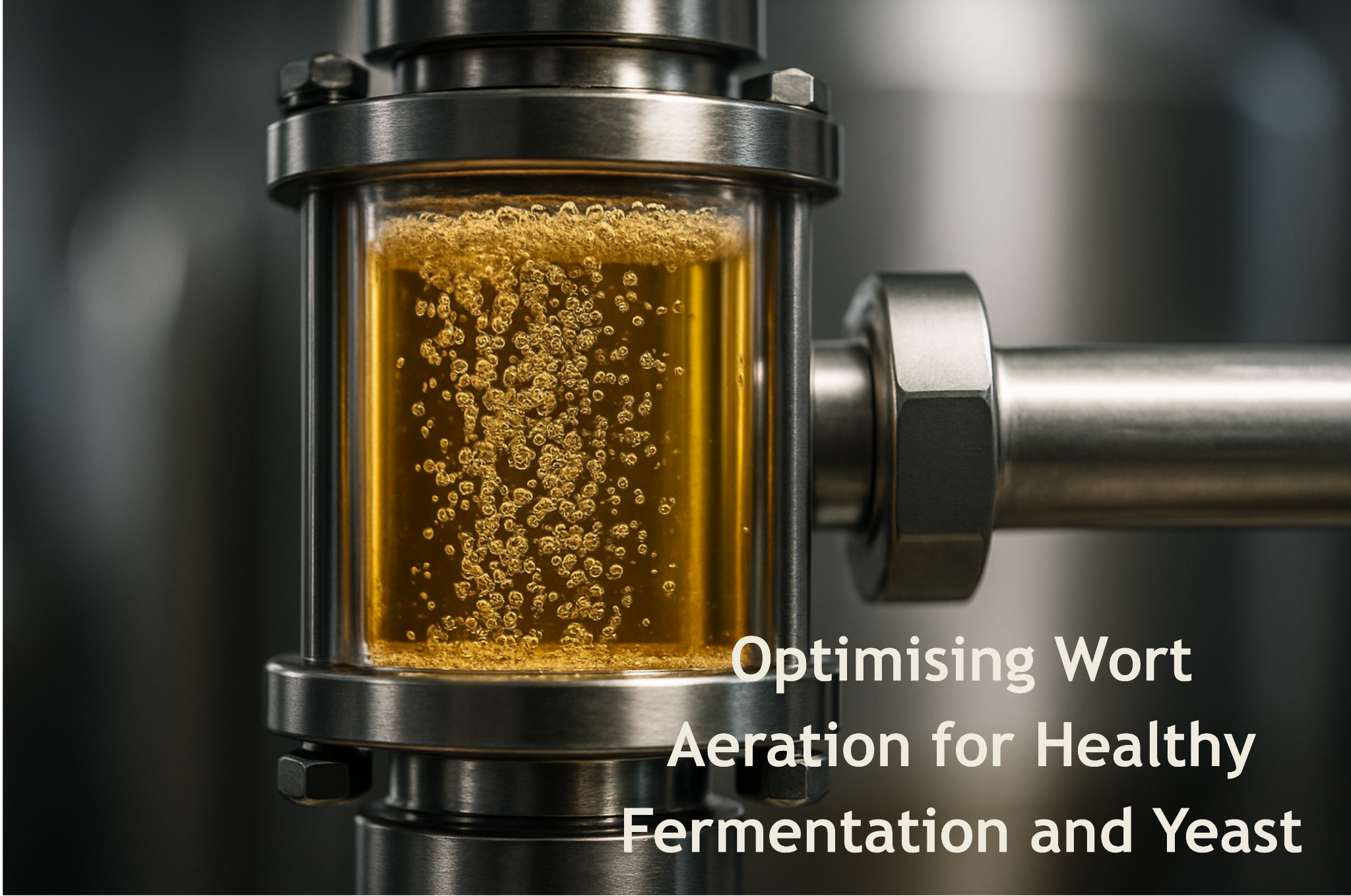Wort aeration (or oxygenation) is one of the critical early control points in brewing. Yeast requires oxygen during the early growth/adaptation phase for synthesis of membrane lipids (sterols, unsaturated fatty acids) and for achieving healthy cell intracellular physiology.
Sub‐optimal aeration can lead to sluggish or stuck fermentations, poor attenuation, off‐flavours, low yeast vitality/viability, and poorer outcomes when repitching.
Over‐aeration can also have downsides (e.g. oxidative effects, off‐flavour precursors), so there is a sweet spot, dialling in wort aeration properly is especially relevant for consistency, cost control (via repitching), and flavour quality.
For AEB yeast strains, an oxygen concentration of 8-10 mg/L of O2 is recommended for optimal performance. Below we explore how wort aeration influences key aspects of the brewing process.
Implications for Repitching: Yeast Health Over Generations
Wort Aeration: Optimising Dissolved Oxygen for Healthy Fermentation and Yeast
For breweries that repitch yeast (especially lager yeasts)
Yeast health is cumulative. If yeast were inadequately oxygenated during previous fermentations or propagation, membrane damage or low sterol/UFA content can accumulate, reducing viability/vitality.
Ensuring proper aeration both in yeast propagation and in wort for every pitch helps maintain high viability, consistent ferment kinetics, reduces lag in subsequent batches, and improves flavour stability.
As repitches proceed, some strain degeneration or stress accumulation is inevitable; but good aeration slows this, keeps viability high, reduces generation of oxidative damage, fosters more consistent performance.
Fermentation Health and Kinetics: The Downstream Benefits of Proper Wort Aeration
The presence of sufficient dissolved oxygen (DO) in the early stages of fermentation affects the length of the lag phase, ferment speed, attenuation, and the risk of fermentation faults or delays.
The clock inside: Lag Phase and Start of Fermentation
Once pitched, yeast cells must adapt to the wort environment. During this lag or adaptation phase, aerobic metabolism dominates, enabling the yeast to synthesise sterols and unsaturated fatty acids—key membrane components needed for healthy budding and ethanol resistance.
Under-aerated wort (e.g. ≤ 6 mg/L DO) typically leads to prolonged lag phases (potentially 8–12 hours longer).
This delay not only slows production schedules but also increases the risk of microbial contamination, especially in warm fermenters or in open systems.
Yeast Division and Biomass Build-up
With adequate oxygen—typically 8–10 mg/L DO—yeast undergoes more robust budding cycles, resulting in:
Higher biomass yield
A greater proportion of young, active cells
Improved vitality and viability, which supports full attenuation even in high-gravity worts.
This not only benefits the current fermentation but also improves the quality and reusability of yeast for future pitches. Over multiple repitching cycles, wort oxygenation becomes a compounding variable for maintaining strain performance.
Fermentation Rate
One of the most immediately observable benefits of proper wort oxygenation is a faster, more consistent fermentation curve.
Research has shown that supplying DO from ~6 mg/L to ~10 mg/L can:
Reduce total fermentation time by 15–25%
Improve the predictability of time to terminal gravity
Minimise residual sugars or diacetyl if all other parameters (e.g. temperature, pitch rate) are consistent
This has strong implications for brewhouse scheduling, tank turnover, and consistency between batches—particularly in lagers or specialty ales where timelines are tight or flavour drift is commercially sensitive.
In the graph below, you can observe that fermentation time to terminal gravity decreases significantly between 6 and 10 mg/L DO, plateauing beyond that point. This supports the industry consensus that 10–12 mg/L DO represents a practical ceiling, beyond which few gains are realised.
References
Risks of Inadequate or Excessive Oxygenation
Optimised Aeration: Summary of Effects on Brewing
Beugholt, A., Curic, M., Hauser, T., & Krottenthaler, M. (2024). The role of yeast propagation aeration for subsequent primary fermentation in lager beer production. International Journal of Food Science & Technology, 59(10), 7346–7356. https://doi.org/10.1111/ijfs.17290
Kucharczyk, K., Tuszyński, T., & Głowacka, A. (2017). The effect of wort aeration on fermentation, maturation, and volatile components of beer produced on an industrial scale. Journal of the Institute of Brewing, 123(3), 397–404. https://doi.org/10.1002/jib.392
Wyeast Laboratories. (n.d.). Professional oxygenation & aeration. Wyeastlab.com. https://wyeastlab.com/resource/professional-oxygenation-aeration/
BYO – Brew Your Own. (n.d.). Wort aeration: Getting oxygen into your beer. https://byo.com/article/wort-aeration/
Atlas Copco. (n.d.). The role of sterile air filtration in wort aeration. https://www.atlascopco.com/en-au/compressors/air-compressor-blog/sterile-air-filtration-wort-aeration
ABT Tanks. (n.d.). Wort Aeration: A comprehensive yeast oxygenation guide. https://abtanks.com/pages/wort-aeration-a-comprehensive-yeast-oxygenation-guide
Ana Victoria Vasquez de la Peña
ana@neumaker.com.au
10th October 2025
© 2025 neumaker. All rights reserved. This article may be shared/forwarded for personal or educational purposes, provided it remains unaltered and includes proper attribution. Reproduction, distribution, or use in any other form—including but not limited to commercial purposes, republishing, or adaptation—without explicit written permission is strictly prohibited.






